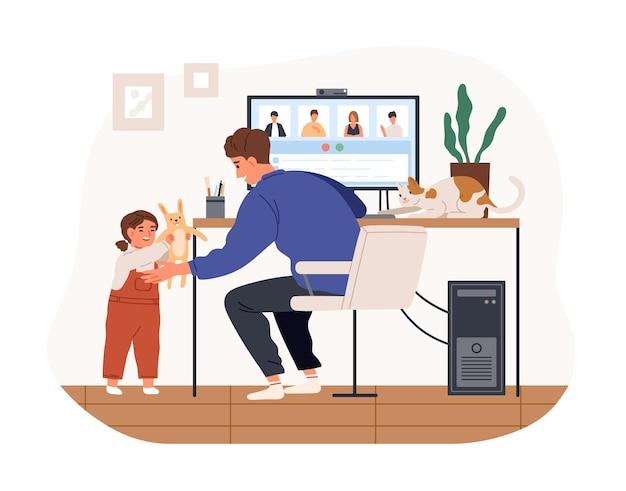Collaboration is often touted as a crucial ingredient for success in today’s fast-paced and interconnected world. It promotes teamwork, innovation, and diversity of thought, all of which are essential for tackling complex problems and making informed decisions. However, it’s important to recognize that collaboration is not without its flaws. In this blog post, we will dive deep into the disadvantages of group discussion, exploring the potential pitfalls and challenges that can arise when working together.
Many organizations rely on group discussions as a means to foster creativity and find solutions to various challenges. Nevertheless, these sessions can sometimes lead to inefficiency, groupthink, and an overall lack of productivity. We’ll explore these downsides and shed light on why collaboration, while crucial, can sometimes fail to deliver the desired outcomes. Furthermore, we’ll explore the role of online collaboration tools and the current problems faced by virtual teams in today’s digital world.
If you’re interested in understanding the not-so-glamorous side of collaboration and the challenges that group discussions can present, keep reading. In exploring the disadvantages of collaboration, we’ll gain valuable insights into how to overcome these obstacles and make the most out of teamwork. So let’s delve into the world of collaborative pitfalls and discover how to navigate them in our ever-changing professional landscape.
Stay tuned for an in-depth analysis of the disadvantages of group discussion and how they impact collaboration in an interconnected world.

Disadvantages of Group Discussion
Groupthink Gone Wild
Group discussions can sometimes foster a phenomenon known as “groupthink.” This is when a group of people prioritize conformity over critical thinking, leading to a lack of diverse perspectives and alternative solutions. It’s like stepping into the Twilight Zone, where everyone nods in agreement and original ideas are devoured by the mighty force of conformity. Suddenly, creativity takes a backseat and the group becomes a hive mind of repetitive thoughts. Think of it as a cult, but without the Kool-Aid.
Time Warp Takes Over
Remember that time you had a group project and ended up spending more time discussing who should bring the donuts than actually getting things done? Well, group discussions can swiftly turn into a black hole of time-wasting. With everyone wanting their voice to be heard, discussions can drag on forever, leading to productivity plummeting faster than a lead balloon. Cue the Jeopardy! theme song as you wait for someone to finally make a decision. Time is precious, so use it wisely and beware the group discussion time warp!
The Domino Effect of Dominating Debaters
In the land of group discussions, there’s always that one person who thinks their voice should drown out everyone else’s. They dominate the conversation like it’s an Olympic sport, leaving no room for others to share their thoughts. It’s like being stuck in a never-ending Ted Talk, but without the inspiring message or the option to hit pause. These dominating debaters can squash the opportunity for quieter voices to be heard, stifling creativity and diverse perspectives. It’s a battle of the vocal cords, and unfortunately, not everyone comes out a winner.
The Annoying Echo Chamber
Group discussions can easily become an echo chamber, where ideas are constantly bounced back and forth without any fresh air creeping in. Instead of challenging each other’s perspectives, the group ends up confirming their own biases and reinforcing existing beliefs. It’s like living in a parallel universe where dissenting opinions are banished to the shadows, and group members simply nod along in harmony. Nurture diversity of thought and embrace the beauty of disagreement, because an echo chamber won’t lead you anywhere other than a stagnant pool of unchallenged ideas.
Fishbowl Extravaganza
Ever felt like you were being watched by a tank full of judgmental goldfish during a group discussion? It’s not just your imagination; the fishbowl effect is real. In a group setting, some individuals might feel uncomfortable expressing their honest opinions due to the fear of being judged or criticized. Like goldfish swimming circles in a tiny bowl, people may feel trapped and unable to truly be themselves. This can hinder authentic communication and hinder the exploration of diverse perspectives. So, let’s break the glass of conformity and let every fish swim free!
While group discussions can be beneficial in many ways, it’s essential to be aware of their potential downsides. Groupthink, time-wasting, dominating debaters, echo chambers, and the fishbowl effect can all dampen the effectiveness and diversity of ideas in group discussions. By being conscious of these disadvantages, we can strive to create inclusive and productive discussions that encourage innovative thinking and open-mindedness. So, gather your thoughts, respect differing opinions, and navigate the potential pitfalls of group discussions with grace and a touch of humor.

Disadvantages of Group Discussion: Frequently Asked Questions (FAQ)
Collaboration is key to success in today’s world. However, like anything else, group discussions also have their downsides. In this FAQ-style subsection, we’ll address common questions and concerns about the disadvantages of group discussion and collaboration, and why online collaboration tools have become essential in the modern era.
Why is Collaboration Important
Collaboration allows individuals to harness the power of collective knowledge and skills. By working together, teams can achieve more than they could individually. It promotes innovation, encourages diverse perspectives, and fosters a sense of camaraderie among team members.
What Are the Disadvantages of Group Discussion
While group discussions offer numerous benefits, they do have a few drawbacks. Here are some disadvantages to keep in mind:
1. Time-consuming
Group discussions can be quite time-consuming, especially when it comes to decision-making. As multiple individuals share their opinions, the process can be prolonged, leading to potential delays in executing actions or making progress.
2. Dominant Personalities
In group discussions, dominant personalities tend to overshadow quieter individuals. These assertive individuals may take over the conversation, making it difficult for others to express their thoughts and ideas. This can hinder creativity and prevent everyone from having an equal say.
3. Groupthink
Groupthink is a phenomenon in which the desire for group consensus overrides critical thinking. In some cases, individuals might conform to popular opinions without thoroughly examining alternative solutions. This can lead to a lack of innovative thinking and hinder problem-solving.
4. Conflicts and Miscommunication
Collaboration often involves diverse individuals with differing viewpoints. Disagreements and conflicts can arise, causing friction within the group. Additionally, miscommunication can occur due to different communication styles or language barriers, leading to misunderstandings and inefficiencies.
Why Do We Need Collaboration Tools
Collaboration tools have become essential in today’s digital age. They offer unique advantages over traditional methods of collaboration. Here’s why we need these tools:
1. Enhanced Accessibility and Flexibility
Collaboration tools enable individuals to work together remotely, regardless of their physical location. This flexibility allows teams to collaborate across time zones and eliminates the need for everyone to be in the same physical space. It promotes a global perspective and increases accessibility to talents worldwide.
2. Seamless Communication
These tools provide a platform for seamless communication among team members. Features such as instant messaging, video conferencing, and file sharing ensure that everyone stays connected and informed. Clear and effective communication helps overcome barriers and promotes efficient collaboration.
3. Streamlined Workflow
Collaboration tools often offer project management features, allowing teams to track progress, assign tasks, and manage deadlines. This helps streamline workflow, ensuring that everyone is on the same page and tasks are completed on time.
What Is the Purpose of Online Collaboration Tools for Working Together
The purpose of online collaboration tools is to facilitate effective teamwork and bring individuals together regardless of geographical boundaries. These tools provide a virtual space for individuals to collaborate, allowing them to share ideas, files, and insights seamlessly. By leveraging technology, online collaboration tools enhance productivity and enable teams to work as smoothly as if they were in the same room.
What Are the Disadvantages of Collaboration
Collaboration, despite its benefits, can also present a few disadvantages. Here are some worth considering:
1. Potential for Conflicts
Collaboration involves working closely with others, which can lead to conflicts and clashes of personality or ideas. If not managed well, these conflicts can negatively impact the team dynamic and overall productivity.
2. compromised Decision-making
While collaboration promotes collective decision-making, it can sometimes result in compromised decisions. When individuals prioritize consensus over critical thinking, they may settle for subpar solutions rather than exploring more innovative or effective alternatives.
3. Overreliance on Collaboration
Relying too heavily on collaboration can hinder individual autonomy and accountability. If team members become overly dependent on group discussions, they may neglect to take individual initiative or ownership of tasks, leading to decreased efficiency.
What Are the Advantages and Disadvantages of Collaboration
Collaboration brings both benefits and drawbacks. Let’s summarize them below:
Advantages:
– Enhanced innovation and creativity through diverse perspectives
– Increased efficiency by leveraging collective knowledge and skills
– Improved problem-solving through collaboration and brainstorming
– Fostered camaraderie and teamwork among team members
Disadvantages:
– Time-consuming decision-making process
– Dominant personalities overshadowing quieter individuals
– Potential for groupthink and lack of critical thinking
– Conflicts and miscommunication due to differing viewpoints and communication styles
What Is the Key to Collaboration
The key to successful collaboration lies in effective communication, active listening, and creating a safe space for everyone to contribute. Respect for diverse viewpoints, open-mindedness, and a willingness to consider alternative ideas also play crucial roles. By fostering an inclusive and supportive environment, collaboration can thrive.
What Is the Current Problem with Online Collaboration
While online collaboration has revolutionized how teams work together, it does come with some challenges. One prominent issue is the potential for miscommunication or misunderstandings due to the absence of non-verbal cues. Without face-to-face interaction, it’s important to be mindful of how messages are conveyed and interpreted. Clarity in communication becomes paramount when physical presence is replaced by virtual interaction.
What Are the Advantages, Benefits, and Disadvantages of Online Collaboration
Online collaboration brings several advantages and benefits to the table. However, it does have a few potential drawbacks. Here’s a summary:
Advantages and Benefits:
– Increased accessibility and flexibility for remote work
– Seamless communication and instant connectivity
– Streamlined workflow management
– Global perspective and access to a diverse talent pool
Disadvantages:
– Potential for miscommunication due to absence of non-verbal cues
– Technical difficulties and reliance on stable internet connection
– Potential for decreased personal connection and camaraderie
In conclusion, while group discussion and collaboration have their disadvantages, leveraging online collaboration tools can mitigate many of these challenges. By understanding the potential drawbacks and optimizing communication and workflow, teams can fully reap the benefits of collaboration while minimizing its downsides. So, embrace the power of collaboration while being mindful of its limitations, and watch your team stride towards success!
Disclaimer: The content generated in this blog post does not reflect personal opinions and is intended for informational purposes only. The disadvantages mentioned may not be applicable to every situation, and results may vary.
